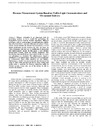Identificador persistente para citar o vincular este elemento:
https://accedacris.ulpgc.es/jspui/handle/10553/55586
| Campo DC | Valor | idioma |
|---|---|---|
| dc.contributor.author | Rodriguez, R. | en_US |
| dc.contributor.author | Rabadán Borges, José Alberto | en_US |
| dc.contributor.author | Guerra Yánez, Víctor | en_US |
| dc.contributor.author | Rufo, J. | en_US |
| dc.contributor.author | Pérez Jiménez, Rafael | en_US |
| dc.date.accessioned | 2019-05-31T11:43:44Z | - |
| dc.date.available | 2019-05-31T11:43:44Z | - |
| dc.date.issued | 2016 | en_US |
| dc.identifier.isbn | 978-1-61208-514-2 | - |
| dc.identifier.uri | https://accedacris.ulpgc.es/handle/10553/55586 | - |
| dc.description.abstract | Distance estimation is an important task in positioning systems, as it is needed for performing the triangulation process used by location algorithms. Different techniques, such as received signal strength indication (RSSI), time of arrival (ToA), and time difference of arrival (TDoA), can be used to estimate the distance between devices. Cricket indoor positioning systems, designed by MIT, are based on TDoA techniques, and they use a combination of ultrasound and radiofrequency signals. In this paper, a new distance measurement scheme based on Cricket technology, but introducing some modifications, is proposed. In this way, some new advantages are obtained. The radiofrequency signal is substituted by an optical signal, making the system applicable to environments where radio emissions are not suitable. Furthermore, a double-way measurement is also introduced, in order to allow both measurement devices (base station and mobile node) to perform the distance estimation, unlike in Cricket systems, where only one of the devices is able to calculate the distance. | en_US |
| dc.language | eng | en_US |
| dc.source | The Twelfth International Conference on Wireless and Mobile Communications ICWMC 2016 (ICWMC 1 / INPOTRA I: Indoor positioning and tracking I) | en_US |
| dc.subject | 33 Ciencias tecnológicas | en_US |
| dc.subject.other | Distance estimation | en_US |
| dc.subject.other | VLC | en_US |
| dc.subject.other | Time arrival | en_US |
| dc.subject.other | Double measurement | en_US |
| dc.title | Distance measurement system based on visible light communications and ultrasound emitters | en_US |
| dc.type | info:eu-repo/semantics/conferenceObject | es |
| dc.type | ConferenceObject | es |
| dc.investigacion | Ingeniería y Arquitectura | en_US |
| dc.type2 | Actas de congresos | en_US |
| dc.identifier.ulpgc | Sí | es |
| item.fulltext | Con texto completo | - |
| item.grantfulltext | open | - |
| crisitem.author.dept | GIR IDeTIC: División de Fotónica y Comunicaciones | - |
| crisitem.author.dept | IU para el Desarrollo Tecnológico y la Innovación | - |
| crisitem.author.dept | Departamento de Señales y Comunicaciones | - |
| crisitem.author.dept | GIR IDeTIC: División de Fotónica y Comunicaciones | - |
| crisitem.author.dept | IU para el Desarrollo Tecnológico y la Innovación | - |
| crisitem.author.dept | GIR IDeTIC: División de Fotónica y Comunicaciones | - |
| crisitem.author.dept | IU para el Desarrollo Tecnológico y la Innovación | - |
| crisitem.author.dept | Departamento de Señales y Comunicaciones | - |
| crisitem.author.orcid | 0000-0002-9994-4495 | - |
| crisitem.author.orcid | 0000-0002-6264-7577 | - |
| crisitem.author.orcid | 0000-0002-8849-592X | - |
| crisitem.author.parentorg | IU para el Desarrollo Tecnológico y la Innovación | - |
| crisitem.author.parentorg | IU para el Desarrollo Tecnológico y la Innovación | - |
| crisitem.author.parentorg | IU para el Desarrollo Tecnológico y la Innovación | - |
| crisitem.author.fullName | Rabadán Borges, José Alberto | - |
| crisitem.author.fullName | Guerra Yanez, Victor | - |
| crisitem.author.fullName | Pérez Jiménez, Rafael | - |
| Colección: | Actas de congresos | |
Visitas
98
actualizado el 01-nov-2024
Descargas
117
actualizado el 01-nov-2024
Google ScholarTM
Verifica
Altmetric
Comparte
Exporta metadatos
Los elementos en ULPGC accedaCRIS están protegidos por derechos de autor con todos los derechos reservados, a menos que se indique lo contrario.
